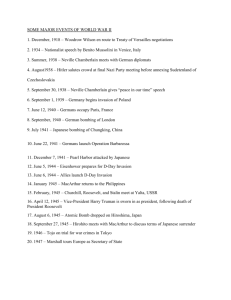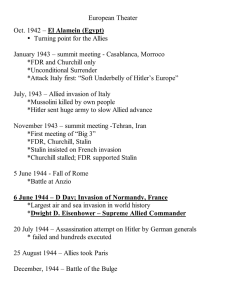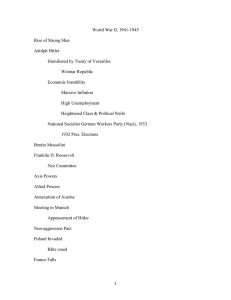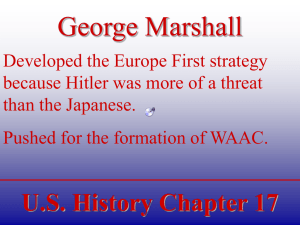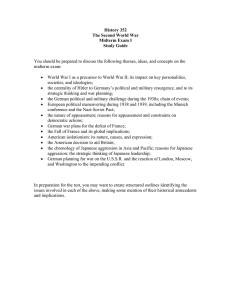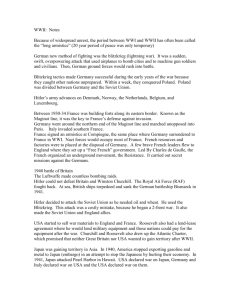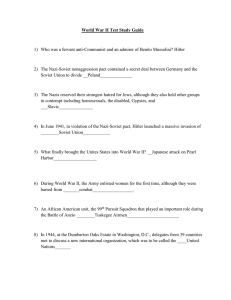The Roots of War
advertisement
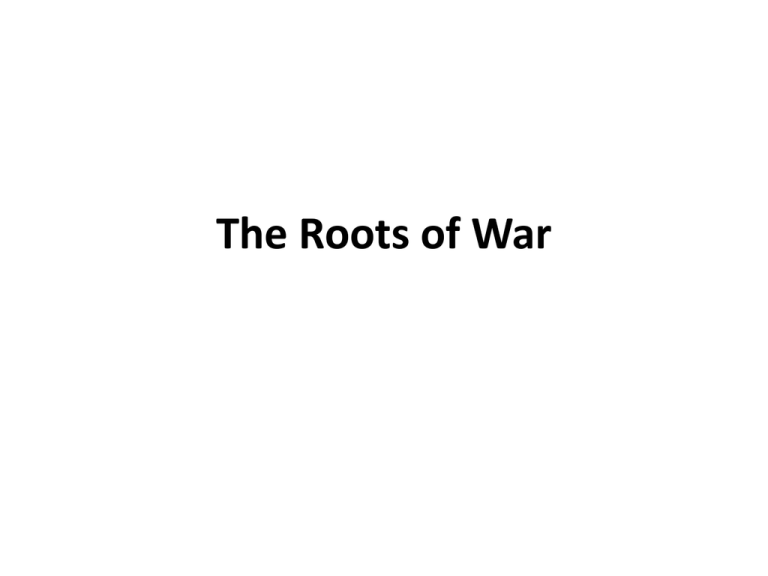
The Roots of War Treaty of Versailles, 1918 • Created a set of small new nations in Eastern Europe = vulnerable to aggression from larger neighbors (Germany & Soviet Union) • Italy & Japan = failed to recognize their stature as world powers • Germany = betrayed (Stab in the back myth) rather than defeated (this leads to the unconditional surrender demand), harsh war reparations and loss of lands 1920’s & 30’s • Economic crisis and political instability fueled the rise of right-wing dictatorships that offered territorial expansion by military conquest as way to redress old rivalries, dominate trade, and gain access to raw materials (Hitler, Germany; Mussolini, Italy; Franco, Spain; Stalin, Russia; Emperor Hirohito, Japan) Japanese Nationalism • Wanted to expel Europeans and Americans from Asia and create a Greater East Asia Co-Prosperity Sphere (Asia controlled by Japanese) • Japanese ambition in Asia was to create a Pan-Asian empire with Japan at the center as an imperial power and a defensive ring of 500 miles to protect the homeland. • Most of Japanese territorial gains would be in China, Southeast Asia, and the Pacific Islands • Earliest national aggression in WWII was when Japan invaded Manchuria in 1931 • In 1937 Japan launched a brutal invasion of China European Nationalism • Expansion of territories through military aggression • Italy: conquest of Ethiopia in 1935 & intervention in Spain in support of Gen. Franco • Germany: Hitler made himself the German Fuhrer, 1934 (absolute leader) • Thousand Year Reich – combined historic German interest in eastward expansion with tradition of German racial superiority • Lebensraum (living space) created by taking land from the Russian Slavic peoples European Nationalism • Genocide (systematic murder) of the Jewish people of Europe • Nuremburg Laws, 1935 denied civil rights to Jews • NAZI government took Jewish property and excluded Jews from most jobs • Concentration Camps were prisons created by the Nazis to punish political dissidents, Jews, Gypsies, homosexuals, and other ethnic groups considered undesirable • The camps evolved into harsh labor camps and finally into extermination camps Rome-Berlin Axis, 1936 • Alliance between Germany & Italy • Grew into the Tripartite Act, 1940 which included Japan • Alliance of Germany, Italy, and Japan became known as the Axis Powers (aggressor nations) Hitler’s War in Europe Pre-War territorial expansion • 1936 – re-occupied the German Rhineland, violated terms of Versailles by re-militarizing Germany • 1938 – annexed (added) Austria • Sept. 1938 – Munich Agreement = forced Czechoslovakia to cede the Sudetenland to Germany • March 1939 – Germany occupied the majority of Czechoslovakia German invasion of Poland • Sept. 1, 1939 triggered start of WWII in Europe • Blitzkrieg invasion “lightening war” included armored divisions with tanks and motorized infantry rapidly seized control of territory (new form of warfare which made trench warfare of WWI obsolete) • Nazi-Soviet Non-Aggression Pact, 1939 – cleared the way for Hitler’s invasion of Poland with Germany & Russia splitting the country between them War in Europe: 1939-1941 • May 1940 -German invasion of Denmark & Norway to the North • May & June 1940 – German invasion of Netherlands, Belgium, and France to the West • Defeat of France led to the narrow escape of British soldiers from the beach at Dunkirk back to England • Vichy French (Pro-Nazi) government established under French Gen. Marshall Petain to govern southern France during the war • General Charles de Gaul – continued to lead the French forces War in Europe: 1939-1941 • Summer of 1940 –German aerial attack of Great Britain (Battle of Britain) • Failed to subdue Great Britain who would continue the war against Germany • May 1941 –Germany enlisted Hungary, Rumania, and Bulgaria as allies and conquered Yugoslavia and Greece to the South in the Balkans • June 1941 = unable to knock Great Britain out of the war, Hitler invaded the Soviet Union in the East • Invasion caught Soviets off-guard due to the non-aggression pact • Heavy losses by the Soviets coupled with deep penetration of German, Italian, and Rumanian forces into the Soviet Union led to the near capture of Moscow and other strategic cities American Isolationism Americans didn’t want foreign wars (Isolationism) • People who opposed intervention in the war considered themselves realists • Emotional appeal of neutrality came from disillusionment with WWI which failed to make the world safe for democracy • Hitler’s breaching of the Treaty of Versailles on multiple occasions furthered this disillusionment • Opponents of the war did want the US to protect its traditional spheres of interest in Latin America & the Pacific Edging Toward Intervention • The “Destroyer deal” with Great Britain – trade of fifty old destroyers for the use of bases on British territories in Caribbean, Bermuda, and Newfoundland. • Election of 1940: FDR became the first president in history to run for a 3rd term. • FDR won the election with 55% of the votes – defeated Republican Wendell Wilkie • FDR pledged no American would fight in a foreign war • Privately, Roosevelt knew U.S. would enter the war The Brink of War • Lend-Lease Program (1941): allowed Britain to “borrow” military equipment for the duration of the war • Opposition to the program: America First Committee – claimed the lend-lease would allow the president to declare anything a “defense articles.” • FDR’s undeclared war: instructed U.S. navy to report German submarine sightings to the British • “shoot on sight” policy – U.S. ships should attack German subs when they make contact • U.S. naval escort of British convoys to within 400 miles of Great Britain • Germany responded by sinking 2 U.S. destroyers killing 100 men. The Brink of War • The Atlantic Charter: August 1941, provided a political umbrella for American involvement • FDR & Winston Churchill (GB) agreed that the first priority was to defeat Germany; Japan was secondary • FDR wanted to eliminate Hitler without going to war if possible • U.S. decision to build a two-ocean navy (Atlantic & Pacific) – decision antagonized Japan • U.S. buildup would reduce Japanese naval strength • U.S. was gradually restricting Japan’s vital imports of steal, iron ore, and aluminum The Brink of War • July, 1941- Japan occupied French Indo-China. As a result, Roosevelt froze Japanese assets in the U.S., blocked petroleum shipments, and began U.S. buildup of forces in the Philippines. • Japanese objective: hoped by attacking American Pacific bases they would shock the United States into letting Japan have its way in Asia or at least time to create impenetrable defenses in the central pacific. • U.S. expected Japanese attacks in Southeast Asia. The Brink of War • December 7, 1941 – Japanese attack at Pearl Harbor: sank 8 battleships, 11 other warships, and killed 2,403 Americans. • President Roosevelt’s speech; “a date that will live in infamy” – U.S. declared war against Japan • U.S. formally declares war on Japan on Dec. 8th, Germany and Italy on Dec. 11th • Germany & Italy declared war on the U.S. on Dec. 11th Mobilizing for Victory Organizing the Economy • The war effort gave Americans a common purpose that softened the divisions of region, class, and national origin while calling attention to continuing inequalities of race. • War Manpower Commission: allocated workers among vital industries and the military • War Production Board: invested $17 billion for new factories, $181 billion in war supply contracts Organizing the Economy • Office of Price Administration (OPA) – fought inflation with price controls and rationing of vital war materials. This convinced Americans to buy war bonds that financed half the war spending • Federal budget grew to $98 billion by 1945 and increased the national debt Organizing the Economy • Major industries transitioned from producing consumer goods to building war machines • These mass production techniques used to build thousands of warplanes and tanks • War-boom cities: developed due to war production (e.g. San Diego) The Enlistment of Science • Office of Scientific Research and Development: Vannevar Bush guided spending on research and development which set the pattern of massive federal support for science that continued after the war. • Manhattan Project: U.S. program to develop an atomic bomb The Enlistment of Science • Physicist Robert Oppenheimer directed the project to design a nuclear fission bomb at Los Alamos • 1st nuclear explosion on July 16,1945 – Trinity site near Alamogordo, New Mexico • Oppenheimer “Now I am become death, destroyer of worlds” Men & Women in the Military • By 1945, 8.3 million men and women were on active duty in the army and army air forces and 3.4 million in the Navy & Marine Corps. • Total 350,000 women / 16 million men served: 292,000 killed / 100,000 prisoners / 671,000 wounded • 25,000 Native Americans served (racially integrated forces) • Code talkers – Navajo Indians who’s language was unknown to the Axis powers African Americans • Approximately 1 million served in the armed services during the war • Served in segregated (separate from white soldiers) units – usually in in non-combat, menial jobs • Faced discrimination on and off the base • All black units (761st tank battalion & 99th pursuit squadron) earned distinguished records for combat action. • The war experience helped to invigorate postwar efforts to achieve equal rights. Japanese Americans • Japanese Americans, unfairly suspected of being possible traitors, in Hawaii and on the west coast are rounded up and shipped to internment camps. • Despite severe prejudice back home, the 442nd Infantry Regiment becomes the highest decorated infantry regiment in the history of the U.S. Army • 8 Presidential Unit Citations • 21 Medal of Honor winners Women in the military • Received mixed reactions by Americans • Armed services tried to not change established gender roles (primarily worked in clerical jobs) • Women’s Airforce Service Pilots (WASP) – civilian auxiliary of U.S. Army Air Forces • Women pilots ferried military aircraft across the U.S., towed targets for anti-aircraft target practice, tested new planes. The War at Home The New American Life • Residents in war production cities – had to cope with new workers (mostly unattached males, young men waiting for their draft call, and older men without their families) • Fear of sexually transmitted diseases • Lives put in fast forward: increase in marriages; 1.2 million • Mixed effects on children: “latchkey kids” of working mothers had to fend for themselves, middle class kids worked to support the war effort (fund raisers, salvage drives) The New American Life • Government censorship to control war images and use of propaganda • The Office of War Information – wanted propaganda in feature films • Hollywood obliges with deluge of jingoistic films • Patriotism in film softens through the war and switches to comedy to keep spirits up New Workers • Women in the work force – replaced men in industrial workforce • Rosie the Riveter (journeymen jobs involving welding and skilled jobs) • Higher pay • By 1944 – 19 million women held paid jobs (up 6 million form 1940) • Women’s share of gov’t jobs increased from 22 to 33 percent • Mexican American Workers – primarily in farming • Bracero program – Mexican gov’t recruited workers to come to the U.S. on six to twelve month contracts New Workers • Native Americans – 40,000 moved to off reservation jobs (worked in military supplies) • War experience accelerated the fight for full civil rights • Congress made Indians citizens in 1924 – but several states continued to deny them the right to vote • National Congress of American Indians, 1944 – efforts led to Supreme Court decision to compel states to allow Indians to vote New Workers • African Americans found economic advancement through war jobs • Labor leader A. Philip Randolph of the Brotherhood of Sleeping Car Porters worked with Walter White of the NAACP to plan “Negro March on Washington” to protest racial discrimination by the federal government • President FDR issued Executive Order 8802, June 1941 – barring racial discrimination in defense contracts and creating the Fair Employment Practices Committee (FEPC) “No discrimination on grounds of race, color, creed, or national origin.” Clashing Cultures • Migration of men and women in search of work during the war led to clashes with traditional boundaries of race and region • African-American migration from the South collided with white workers seeking the same jobs • Racial violence in over 50 cities in 1943 alone • Zoot Suit Wars: Los Angeles, Mexican Americans and Whites erupted into widespread violence including over 400,000 people The War at Home Interment of Japanese Americans • Feb. 19, 1942: President Roosevelt issued Executive Order 9066 – authorized the secretary of war to define restricted areas and remove civilian residents who were threats to national security. • Primary target - 112,000 Japanese Americans in California, Washington, Oregon & Arizona • Outbreak of the war triggered anti-Japanese hysteria Interment of Japanese Americans • April 1942 – Japanese in coastal states were given a week to report to assembly centers where they were then moved to 10 internment camps located in remote areas of the western interior. (How is this like relocation of Native Americans in the 1800’s?) • Japanese responses – some renounced their American citizenship , others sought to cooperate & move to other parts of the country, many young men joined the 442nd Regimental Combat Team Interment of Japanese Americans • Korematsu v. United States (1944) – Supreme Court sanctioned the removal of Japanese Americans to Internment Camps • Japanese Claims Act of 1948 – U.S. government officially recognized its liability to Japanese loses of property as a result of Interment • 1988 – Congress approved redress payments to the sixty thousand survivors The End of the New Deal • New Deal had run out of steam by 1938 • Republican Congress in 1942 – started to undue FDR’s New Deal programs • Election of 1944: Republican candidate – Governor Thomas Dewey of N.Y. • Harry Truman ran as FDR’s vice-Presidential candidate • Roosevelt won his fourth term (432 to 99 electoral votes – but with only 54% of the popular vote) War & Peace • Gathering Allied Strength • Allied victories in North Africa in 1942 & the invasion of Italy in 1943 secured western influence in the Mediterranean Sea & Middle East • U.S & Soviet Union wanted full scale strike at Germany War & Peace • Allied nations began to out produce Germany by 1943 in war materials (Why would this be important to the outcome of the war?) • Casablanca, Jan. 1943 – Roosevelt & Churchill demanded “unconditional surrender” • Tehran Conference, 1943 – U.S & G.B. promised to invade France within 6 months • Stalin wanted control of eastern Europe Victory and Tragedy in Europe Turning the Tide in Europe • Operation Torch – Nov. 8, 1942: British & American forces under command of Gen. Dwight D. Eisenhower attack German forces in North Africa • Battle of the Kasserine Pass – German counter offensive • Axis forces surrendered North Africa in May of 1943 • July – August 1943: British and American armies attacked Sicily, Italy Turning the Tide in Europe • Italian King & army forced Mussolini from power & negotiated peace with allies • Germany occupied most of Italy while allied forces landed in Southern Italy • Bitter fighting lasted until the surrender of Germany in 1945. • Eastern Front: German offensive stopped at the Battle of Kursk in the Soviet Union Operation Overload • D-Day: June 6, 1944 – major amphibious invasion at Normandy, France • Allied forces landed 500,000 men and 100,000 vehicles within 2 weeks • Break-through of the German line at St. Lo • This led to the encirclement of German army at Falaise Operation Overload • Germans lost 250,000 men • Allies liberated Paris on August 25th • Eastern Front: by end of 1944 – Red Army entered the Balkans & reached central Poland Russian Losses • Russians suffered over 20 million casualties (6000 Vista Murrietas, 195 Murrietas) • Equivalent to the deaths of everyone in Nevada, New Mexico, West Virginia, Nebraska, Idaho, Hawaii, Maine, New Hampshire, Rhode Island, Montana, Delaware, South Dakota, Alaska, North Dakota, Vermont and Wyoming Victory & Tragedy in Europe • Allied air strikes – by end of 1944, bombing raids crippled German war production, transportation, and its economy • Dresden – allied air raid using fire bombs destroyed the undefended city killing over 50,000 civilians • Battle of the Bulge: Dec. 16, 1944 – Hitler attempted to break British and American lines by capturing the port city of Antwerp A pile of bodies awaits cremation after the firebombing of Dresden, February 1945 City of Dresden, Germany, after an Allied bombing, February 1945 Victory & Tragedy in Europe • German offensive ran out of gas before it could reach the allied fuel supplies • Collapse of German forces – allied armies crossed the Rhine River in March capturing the industrial center of Germany • On April 25, 1945 – American and Soviet troops met at the Elba River • On April 30 – Hitler committed suicide (Yay! Though 20 years too late.) Victory & Tragedy in Europe • Berlin surrendered to the Soviets on May 2 • VE Day (Victory in Europe Day) – May 8th: Nazi state formally capitulated (unconditional surrender = no “stab in the back” myth) Holocaust • “Final solution” to what Hitler saw as “the Jewish problem” – starting in 1942, Hitler’s SS began a campaign of genocide which focused on the elimination of the Jewish population in Europe. • Death camps such as Auschwitz and Treblinka were used to murder over 6 million Jews and 1 million Poles, Gypsies, and others deemed inferior by the Nazis Berga Concentration Camp Survivors, 1945 A pile of human remains at the site of Nazi concentration camp Majdanek, 1944, Lublin Corpses at Buchenwald, April 1945 Corpses at Buchenwald, April 1945 Einsatzgruppe A members shoot Jews on the outskirts of Kovno, 1941-1942 Executions of Kiev Jews by German army mobile killing units, 1942 Eyeglasses from Auschwitz prisoners, 1945 German SS guards executed after the liberation of Dachau by Allied forces, 1945 German woman forced to see death camps, 1945 Mass Grave Bergen Belsen, May 1945 Members of the Sonderkommando burning corpses on fires in pits at Auschwitz II-Birkenau, 1944 Rows of bodies of dead inmates fill the yard of Lager Nordhausen, a Gestapo concentration camp, 1945 Senator Alben W. Barkley views the evidence at first hand at Buchenwald concentration camp, April 1945 The last Jew in Vinnitsa, 1941 Three emaciated survivors liberated from Buchenwald, April 1945 Ustaše militia execute prisoners at Jasenovac concentration camp Young German boy walks beside corpses of hundreds of prisoners from Bergen Belsen, April 20 1945 Wedding Rings stolen From Buchenwald Inmates, May 5, 1945 The Pacific Theatre and Peace The Pacific War • U.S. war strategy in the Pacific divided responsibilities between Gen. Douglas MacArthur led forces in a “Island hopping campaign” from Australia to the Philippines, and Admiral Chester Nimitz who commanded the Central Pacific fleet. • Plan was to isolate Japan from its southern conquests • British moved from India to retake Burma The Pacific War • With Japans army bogged down in China – Allies planned to bomb Japan • Island Hopping campaign – American naval version of blitzkrieg: planes from aircraft carriers control the skies while navy and land forces isolated and captured the most strategically Japanese-held islands while by passing the rest • Racial hatred between American & Japanese forces intensified the fighting in the Pacific The Pacific War • Leyte Gulf – Allied invasion of Japanese-held Philippines and the destruction of the Japanese fleet leaving the homeland of Japan undefended against invasion • U.S. naval blockade of Japanese imports and heavy bombing of Japanese cities continually weakened Japanese war capabilities • U.S. capture of strategic Japanese islands: Iwo Jima & Okinawa (April-June 1945) Searching for Peace • Yalta Conference (Feb. 1945) – Roosevelt, Churchill, and Stalin debated plans for the postwar world • American goal was to enlist the USSR in finishing off the Japanese • Stalin wanted control of Manchuria, China in exchange for joining the • Stalin would only give vague pledges to allow non-communist to participate in the coalition governments in Eastern Europe Searching for Peace • April 12, 1945 – FDR died of a cerebral hemorrhage • Harry Truman – Vice President succeeds FDR • Potsdam Conference (July 1945) – BritishSoviet-American conference where they debated the future of Germany • Potsdam Declaration - Truman made it clear that the U.S. expected to dominate the occupation of Japan Searching for Peace • Goal was to democratize the Japanese political system and reintroduce Japan into the international community - intended to give Japan an opening for surrender • Sec. of state James Byrnes – urged Truman to use the new atomic bomb • U.S. was convinced Japan would fight to the death in an invasion of the homeland • Using the bomb offered a quick end to the war and it might intimidate Stalin End of the war in the Pacific • U.S. dropped the first atomic bomb on August 6, 1945 at Hiroshima (killed approx. 80,000) and the second on Aug. 8 at Nagasaki (killed approx. 40,000) • V.J. Day: Victory in Japan Day - Japan ceased hostilities on Aug. 14th and surrendered formally on Sept. 2nd • Japanese government signed the terms of surrender on the deck of the USS Missouri a battle ship nearly destroyed at Pearl Harbor on Dec. 7th, 1941 Captain Paul Tibbets in the Enola Gay minutes before takeoff to drop the first atomic bomb on Hiroshima, 1945 Harold Agnew carrying the plutonium core of the Nagasaki Fat Man bomb, 1945 The Fat Man on transport carriage, Tinian Island, 1945 Nagasaki, 20 minutes after the atomic bombing in 1945
